Content
The stock trading app market is booming, with millions of users engaging in this dynamic industry. Investing in a stock trading app is a strategic move for the future. Statista forecasts illustrate that the stock market is projected to grow significantly through 2026. This growth indicates a thriving business opportunity that continues to expand.
Investing in a Stock Trading App? Absolutely Yes! Check out the statistics below to see the promising future of the stock market!


Stock Trading Market Today: Overview
The stock trading app market is estimated to be worth US$16266.1 million in 2023. The projected value of US$1,10,624.4 million will be by 2033. Therefore, the market size is estimated to be 21.1% through 2033. [Source: Grand View Research].
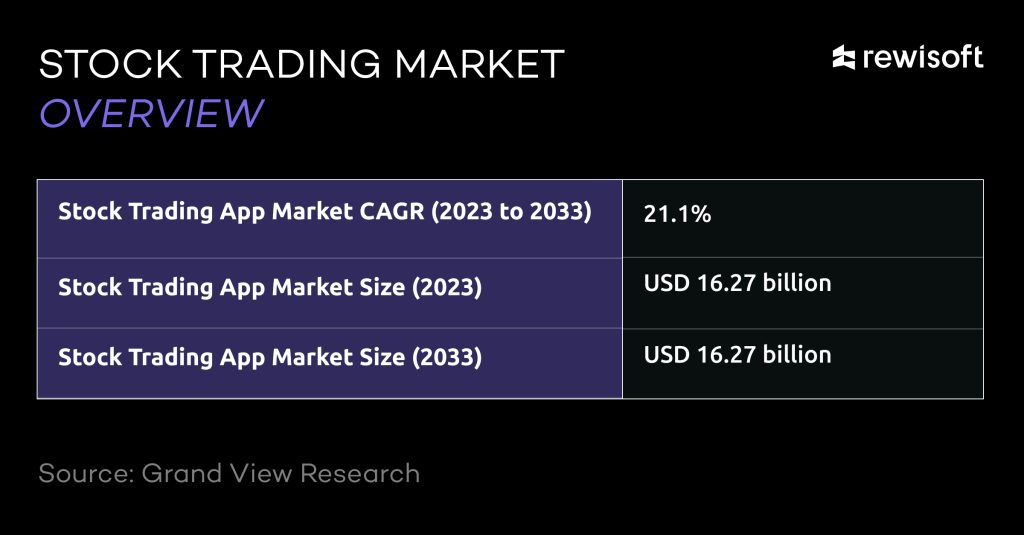

These predictions show the strong growth and growing use of stock market, emphasizing how convenient and efficient they are for investors.
Core Features of a Successful Stock Trading App
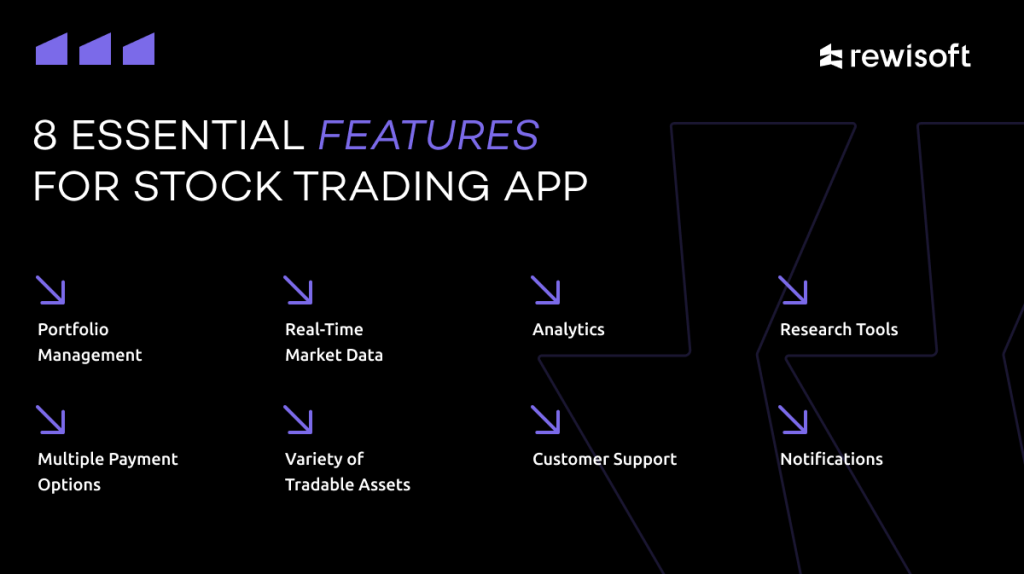

Portfolio
A logically and intuitively developed portfolio is the cornerstone of a stock trading app, allowing users to see and analyze their performance easily. A well-designed portfolio management feature provides several key benefits and functionalities:
- Performance Tracking
Overall portfolio growth with real-time updates. - Diversification Analysis
Asset allocation across stocks, sectors, and asset classes for better risk management. - Detailed Insights
Access to individual stock performance, historical data, and relevant financial metrics. - Customizable Views
Tailor the portfolio view to highlight important metrics and track progress toward financial goals.
Real-Time Market Data
Access to real-time stock prices and relevant market data is a must-have feature for any stock trading app. This feature provides instant metrics on trades and dividends, helping users make more informed decisions. Additionally, it enables users to stay updated with stock market trends, allowing them to compare options and react quickly to changes in the stock market.
Real-time data ensures that users have the most current information to optimize their trading strategies effectively.
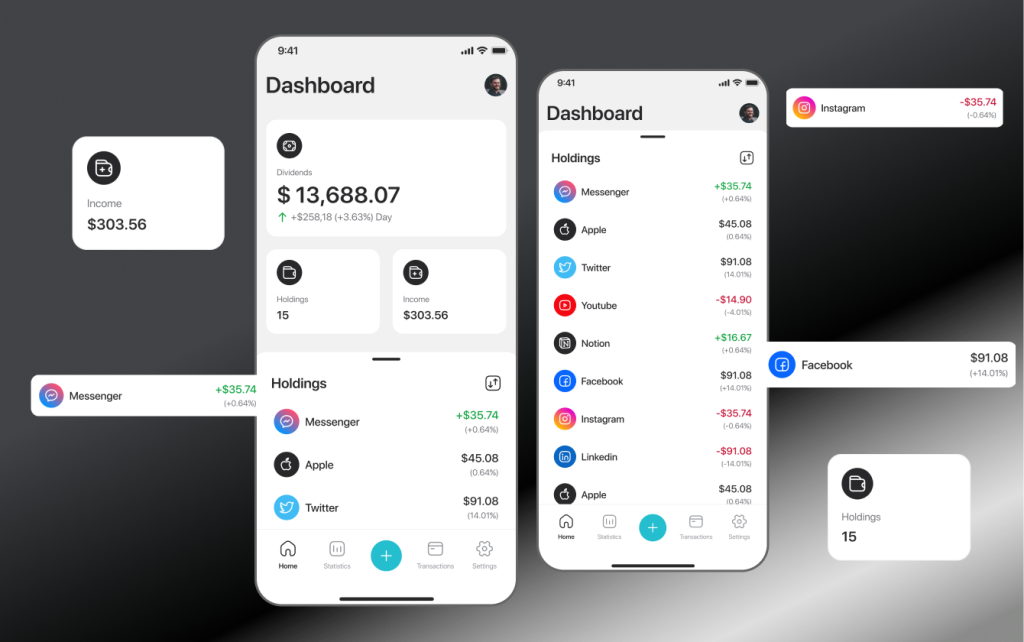

Analytics
Analytics provide valuable insights into user performance, investment decisions, activities, and transactions. When developing stock trading apps, we leverage modern technologies such as machine learning (ML), artificial intelligence (AI), and data science to enable robo-advisory services, which are highly valued by traders and elevate apps to a top-notch status.
For example, we’ve developed an automated solution for advanced performance analytics. This trading app includes features such as tracking returns, dividends, currency fluctuations, and transaction history.
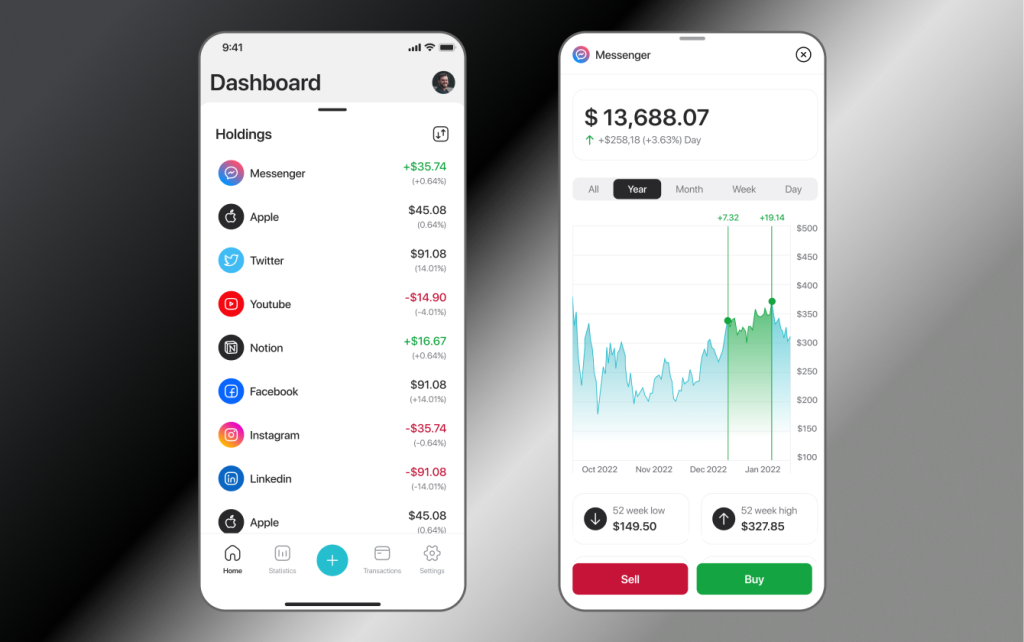

Research Tools
Investing in a stock without understanding the company is risky. That’s why providing comprehensive research stock market tools is crucial. Research tools enable users to conduct in-depth analyses of potential investments. When conducting research, users typically look for:
- What the company does and how it generates revenue.
- Examination of the company’s financials.
- Use price charts to observe medium to long-term trends in the company’s share price history.
- Monitoring stock performance over time.
- Analysis of the competitive landscape and the company’s positioning within that landscape.
Multiple Payment Options & Transactions Management
Did you know that if your trading app doesn’t support the payment methods users seek, they are likely to switch to a competitor? That’s why it’s crucial to offer multiple payment options.
This ensures smooth funding of trading accounts and convenience for a wider audience.
Variety of Tradable Assets
Access to a wide range of tradable assets, such as stocks, ETFs, mutual funds, and more, is essential for catering to diverse investment strategies.
Customer Support
The quality of support service significantly influences customer loyalty. Access to responsive customer support ensures prompt issue resolution and enhances user trust.
Stock trading apps must offer 24/7 customer support, ensuring users’ questions are addressed promptly.
Notifications
Keep your users informed with up-to-date information about their accounts, portfolios, and overall stock market changes. By learning user behavior, analyzing it, and offering personalized smart push notifications, you can enhance user loyalty, retention, and engagement.
Note: Be cautious with the frequency of push notifications, as too many can annoy users.
We’ll reply in 8 working hours (CET)
6 Steps to Build Stock Trading App
Developing own stock trading app is a complex task. These solutions need to offer a wide array of features, adhere to industry standards, demonstrate excellent performance, and meet numerous other requirements throughout the process.
Our custom software development services can effectively address these challenges. Here are the steps we follow in our stock trading app development process:
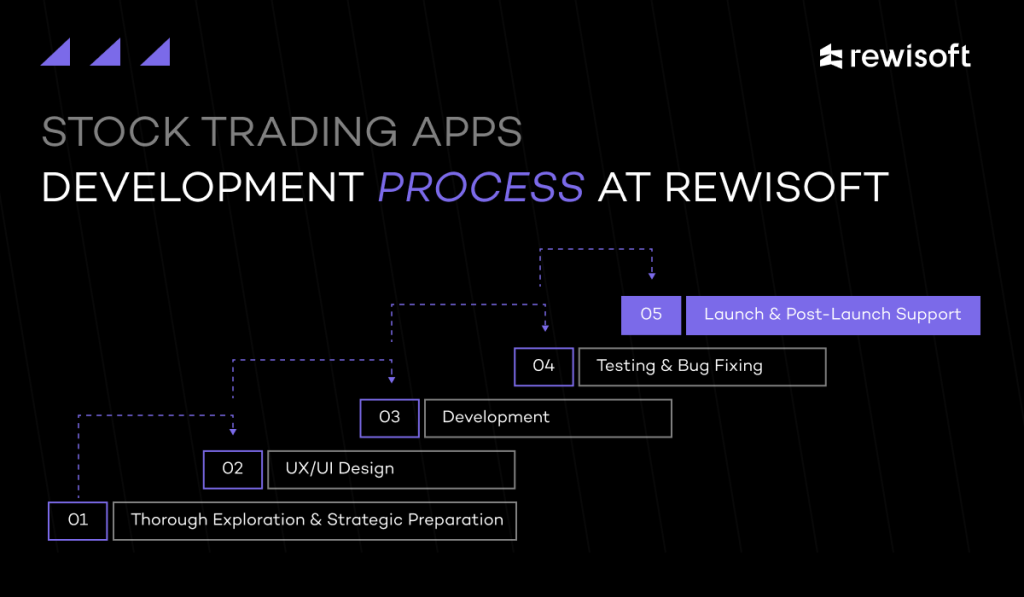

Step 1: Thorough Exploration and Strategic Preparation
Business and User Goals Formalization
Understanding business and user goals is crucial at the start of any project. This step aligns the stock trading app with the company’s objectives and the end users’ needs.
Market Research
Our team conducts extensive market research. We analyze market trends, user demographics, and competitor offerings to find opportunities for differentiation and innovation.
Defining Main Functionality
We define the app’s core functionalities based on the identified goals and market research. This step helps us include core features for a future Stock Trading App.
Setting Technical Requirements
We establish the technical requirements necessary to support the defined functionalities. This step includes selecting the appropriate technologies, frameworks, and tools to ensure the trading app is robust, scalable, and secure.
Determining the Scope of Work
We outline the scope of work for developers and UX/UI designers, ensuring that all aspects of the project are covered.
Project Timeline, Schedule, and Milestones
We create a detailed project timeline with a clear schedule and milestones. This helps us track progress, ensure timely delivery, and manage expectations.
Resource Planning and Team Assembly
We plan the necessary resources, including technology and budget.
Discovery Workshops with Stakeholders
We conduct discovery workshops with stakeholders to gather insights, validate assumptions, and refine the project plan.
After completing all the steps, we’re moving to the next phase – Design Prototyping.
Step 2: Seamless UI/UX Design
A clean and intuitive interface makes navigation easy. It is one of the most important features that engage users. With a well-designed UX, users can make faster decisions and avoid spending extra time searching for features.
An example of a stock market app that we developed for our client Divvy:
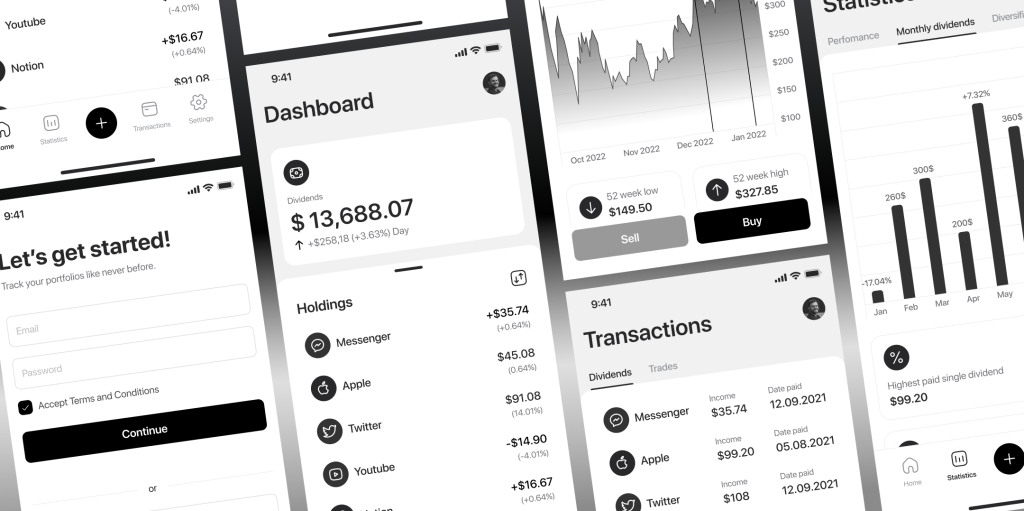

Creating the Design System from Scratch
We start by developing a comprehensive design system from scratch, defining visual elements, style guides, and design patterns to create a consistent and cohesive user experience throughout the stock trading app.
Regular Internal and Client Design Workshops|
We hold regular design workshops with our internal team and the client. These workshops foster collaboration, allowing us to iterate on design ideas, gather feedback, and ensure that the design aligns with the client’s vision and user expectations.
Prioritizing Tasks
We prioritize design tasks based on their importance and impact on the user experience. We prioritize design tasks based on their importance and impact on the user experience. It provides a solid foundation for the overall app design.
Agreeing on Design Concepts
We work closely with the client to finalize design concepts, presenting design mockups, prototypes, and user flow diagrams to ensure all stakeholders are aligned and satisfied with the proposed design direction.
After completing all the UX/UI steps, we’re moving to the next phase – stock market app development.
Step 3: Development
Implementing Product Functionality Feature by Feature
We develop the product functionality step-by-step, closely following the design specifications and Software Requirements Specification documentation.
Regular Team Meetings for Fine-Tuning
We conduct regular team meetings to review progress, address challenges, and fine-tune the product. These meetings foster open communication and collaboration, keeping the app development process on track and promptly resolving any issues.
Code and QA Peer Review
We perform thorough code reviews and quality assurance (QA) peer reviews to maintain high code quality and functionality standards. This process helps identify and fix bugs, improve performance, and ensure the final trading app product is reliable and robust.
Step 4: Careful Testing & Bug Fixing
Testing Product Features and Functionality
We rigorously test all product features and functionalities to confirm that they work as intended. This step includes functional testing to verify that each feature performs correctly and meets user requirements.
Testing Product Integration with Other Systems
We test the product’s integration with other systems to achieve seamless interoperability. We check API connections, data synchronization, and interaction with external services.
Performance Testing
We conduct performance testing to assess the app’s responsiveness, speed, and stability under various conditions, ensuring the trading app can handle high user loads and provide a smooth user experience.
Security Testing
We perform thorough security testing to identify and address potential vulnerabilities. Security testing includes testing for data breaches, encryption issues, and compliance with security standards to protect user information.
Bug Fixing
Any bugs or issues identified during trading app testing are promptly fixed. Our development team works diligently to resolve these problems, ensuring a smooth, error-free stock trading app.
Readiness Check
Before the final launch, we perform a comprehensive readiness check to confirm the app meets all quality standards and is ready for deployment. The final check guarantees that the stock trading app is fully functional, secure, and performs well.
Step 5: Launch & Post-Launch Support
We manage the successful launch of your stock trading app, ensuring a smooth transition from development to production. At this stage, we coordinate with all stakeholders, deploy the app to the relevant platforms, and monitor the initial performance to address any immediate issues.
Post-Support for Free in the First Month
After the launch, we offer free post-launch support for one month. Support includes:
- Monitoring Performance: Monitor the app’s performance to ensure it runs smoothly.
- Bug Fixes: Addressing any bugs or issues that arise post-launch.
- User Feedback: Gathering and analyzing user feedback to make necessary improvements.
- Technical Support: Providing technical support to resolve any user queries or problem
Types of Stock Trading Software
When it comes to selecting a trading platform, your individual needs should be at the forefront of your decision. The available options, such as Apps, Web platforms, Desktop software, Robo-advisory apps, and sell stocks platforms, cater to a variety of preferences.
Let’s concentrate on the most critical investment platforms: Mobile Apps and Web Platforms.
Stock Market App
Due to their convenience and accessibility, mobile apps have become investors’ most popular investment tools. Stock trading apps provide real-time data, enabling investors to manage their investments anytime.
Pros of Stock Trading App:
- Stock trading apps offer the most advanced trading features.
- They provide direct access to cryptocurrency, unlike most traditional brokers.
- They offer a more streamlined and intuitive trading experience.
While stock trading apps are still catching up to big brokers regarding the range of tradable assets, traditional brokers lag in offering intuitive, user-friendly mobile trading platforms.
A stock trading app might be the best choice for a simple and intuitive platform to trade stocks and other assets.
Stock Trading Platform
Trading platforms are designed for professional traders and investors, offering the most comprehensive set of tools and features available. These platforms are known for their advanced charting capabilities, high-speed data processing, and robust analytical tools, making them ideal for serious traders who need precision and reliability.
Pros of Stock Trading Platform:
- Stock trading platforms have sophisticated charting and analytical tools, allowing in-depth market analysis and strategy development.
- These platforms are built to swiftly handle large volumes of data, providing real-time analysis and execution without lag.
- Users can often customize their trading environment extensively, tailoring it to their needs and preferences.
- Many desktop platforms support automated trading strategies, enabling traders to set their algorithms for executing trades.
At RewiSoft, we provide custom development services for App and Desktop platforms, tailoring them to your trading requirements. This personalization enhances your investment experience, ensuring you have the necessary tools to succeed.
Must-Have Security Features
Regarding stock trading, security is the most crucial criterion to ensure safety. Here are the security features our developers implement during the stock trading app development process:
Two-factor authentication (2FA)
We offer a robust security feature called two-factor authentication to ensure the highest level of security. This feature requires users to verify their identity through two separate components: a password and a code sent to their mobile device.
SMS/Email Verification
Users can register quickly via mobile or email. A verification code is sent to the user’s number or email for successful login, adding an extra layer of security to prevent unauthorized access.
Wallet Integration
We integrate secure wallet features into our trading apps to ensure flawless and secure transactions. Wallet Integration includes encryption and other security protocols to protect user funds.
Server-Side Forgery Protection
Our SSF protection features defend against attackers attempting to abuse server functionality, protecting users and servers from such threats.
SSL Encryption
We use Secure Sockets Layer (SSL) to secure internet connections and safeguard sensitive data. SSL encryption ensures that data transferred between users and servers remains private and integral.
Multisig Wallet Integration
We enhance security by integrating multi-signature (multisig) wallets. This feature makes cyberattacks more difficult by increasing the number of potential failure points, requiring multiple signatures to authorize transactions.
How Do Stock Trading Apps Make Money?


Stock trading apps can generate revenue through several business models. The most popular ways to monetize app & trading platform:
Commissions
Traditional revenue sources include charging a fee for each trade executed on the trafing platform. While many modern mobile trading apps offer commission-free trades to attract users, they might charge for specific types of trades or additional services.
Some apps charge fees for account maintenance, inactivity, or subscription-based access to premium features.
Premium Features and Subscriptions
Apps often offer advanced features, tools, and research insights for a subscription fee. These premium services might include real-time market data, advanced charting tools, and personalized investment advice.
In-App Advertising
Some apps display advertisements or sponsored content within the platform. Revenue is generated from advertisers looking to reach the app’s user base.
Affiliate Partnerships
Partnering with financial institutions, providers or other companies allows trading apps to earn commissions for referring users to these partners’ services, such as banking products, credit cards, or other investment opportunities.
Key Features that Make Robinhood Stand Out
Knowing your competitors always makes your product better. Let’s talk about the biggest app giant – Robinhood.
Launched in 2013, Robinhood transformed stock trading by introducing commission-free trades through its mobile app. This innovation marked a significant shift from traditional brokerage firms that typically charged fees for each transaction. Robinhood’s user-friendly design and accessibility attracted a large, younger demographic to the world of stock trading.
Today, Robinhood is one of the leading stock trading apps globally, with millions of users and a high volume of traded stocks. Here are some features that contribute to its success:
Easy-to-Navigate App
Robinhood’s user-friendly interface makes it highly appealing, especially for beginners. Since its inception, the company has focused on creating a customer-centric design, emphasizing the importance of investing in excellent UI/UX design.
Free Cryptocurrency Trading
Robinhood offers free cryptocurrency trading, a feature not commonly found among traditional stock brokerages. However, Robinhood’s crypto offerings are more limited compared to dedicated crypto platforms.
Cash Management and Recurring Investments
Robinhood provides robust cash management features, including an innovative cash card that lets users invest rewards from purchases. Interest on cash sweep accounts can yield up to 1.00%, and the recurring investment feature simplifies the process of automating investments. Robinhood Gold members can earn 5.00% on uninvested cash.
IRA Matching
Robinhood matches customer contributions to their IRAs, offering a 1% match for regular customers and a 3% match for Gold-level subscribers. This feature adds significant value, particularly considering the Gold subscription costs only $50 annually.
Our Approach to Developing a Stock Trading Apps: Cases
Our client, Divvy, won the platinum award for the best app in finance and business. We’re proud to have such a remarkable product in our client portfolio. Let’s delve into the stock trading app development process in detail.
Challenges:
- Develop a solid UI design with advanced features enabling investors to view data on holdings, including current prices, daily changes in value, and overall percentage weight.
- Build a single platform for both novice and experienced investors.
- Create an easy-to-navigate and compelling UX that visualizes investment data with interactive charts.
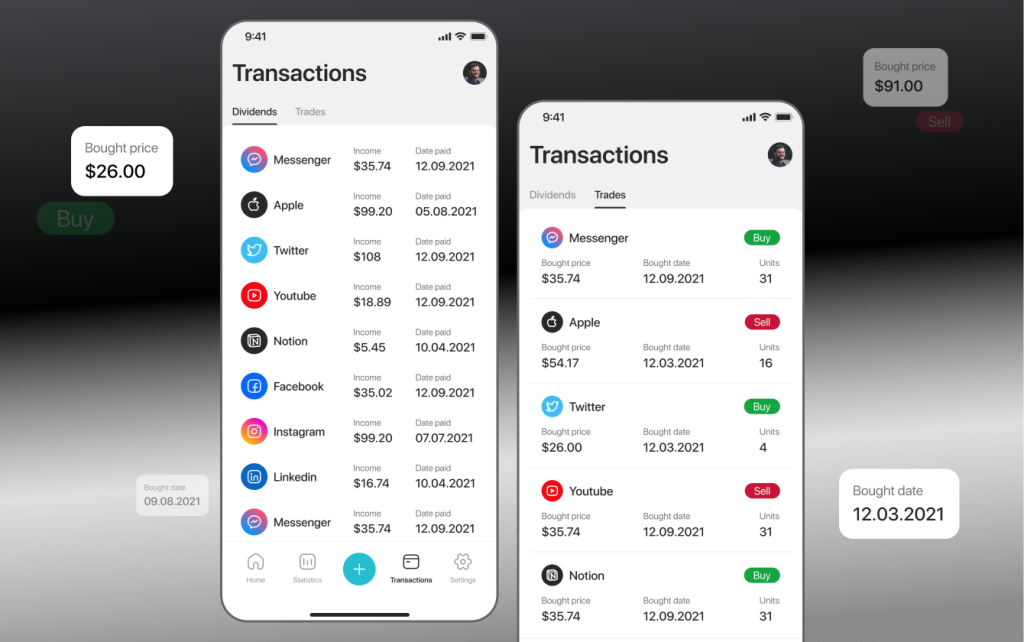

Solutions:
The RewiSoft team successfully developed the following app features:
- Tracking the performance of stocks
- Setting goals for short-term and long-term portfolios
- Interactive diversification charts
- Easy management of stocks
- Customizable stock listings
- Data on returns and percentage weight
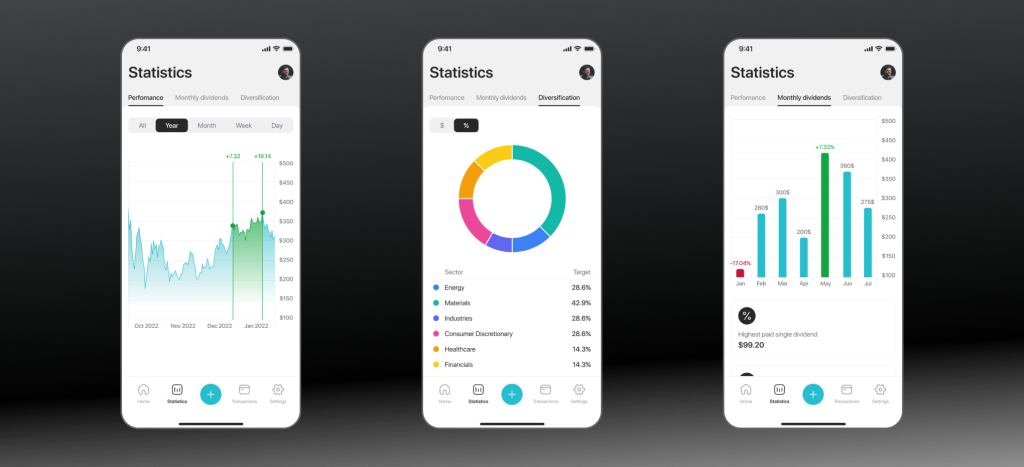

Our mobile app development team designed and developed an iOS mobile app that helps beginners and professionals make the most of their investment journey. Using advanced features created by the RewiSoft team, investors can easily access the data they need and track the overall performance of their investment portfolio.
Read the full success story here: https://rewisoft.com/cases/divvy/
How Much Does It Cost to Build a Stock Trading App?
At RewiSoft, we offer competitive pricing for custom stock trading app development:
- Mobile App Development: Starting at $30,000
- Web Platform Development: Starting at $30,000
The cost of developing a stock trading app depends on several factors, including the technology stack, type of app, design complexity, and company size.


Types of Stock Trading Apps and Their Costs
Simple Stock Trading App
- The simplest and least expensive type of stock trading app. It provides basic functionalities such as tracking stocks, facilitating basic trading processes, and informing users of real-time stock trade news.
- Cost: The lower end of the pricing spectrum.
Mid-Level Stock Trading App
- This type of app is more expensive to develop but includes advanced features such as charting tools, portfolio management, and AI investment assistance.
- Cost: Mid-range pricing.
High-Level Stock Trading Application
- The most sophisticated and expensive type of stock trading app. These applications offer features like robo-advisors, automated trading tools, and in-depth stock market analysis.
- Cost: Higher end of the pricing spectrum.
The overall cost of stock trading app development at RewiSoft starts from $30,000 for mobile and web platforms. The final price depends on the specific requirements and complexity of the app. Whether you need a simple, mid-level, or high-level stock trading app, we provide tailored solutions to meet your needs and budget.
How RewiSoft Can Assist You With Stock Trading App Development
At RewiSoft, we specialize in developing cutting-edge web applications across various industries, including stock trading. With over 80 apps developed in different niches, stock trading app development is significant in our portfolio.
By partnering with us, you’ll get:
- Custom web & app development solutions for your specific requirements.
- A dedicated team committed to delivering high-quality applications.
- Expertise in stock trading app development, backed by a strong portfolio of successful projects.
Let’s achieve outstanding results for your business!








